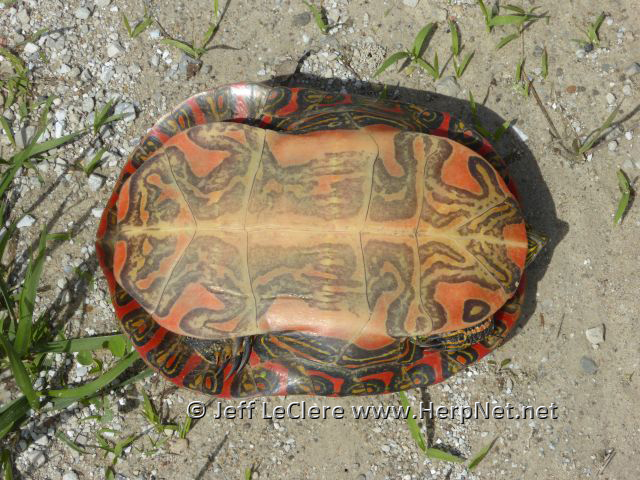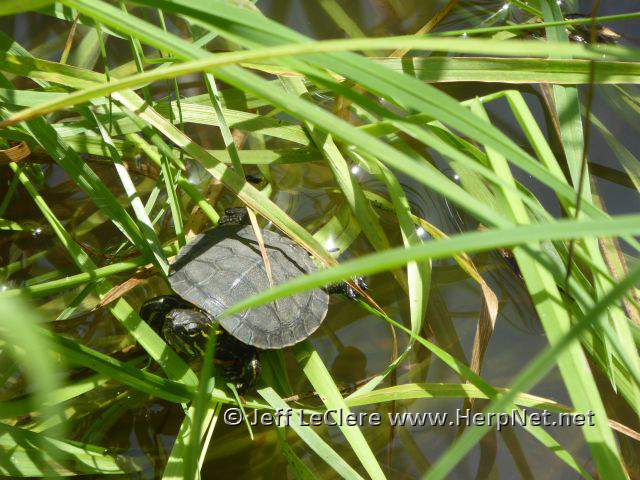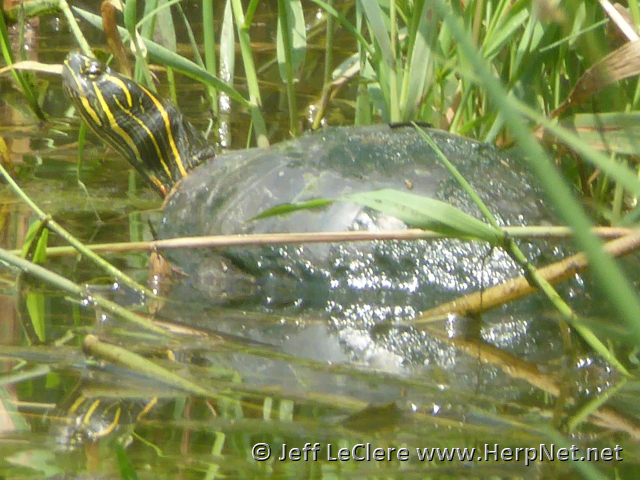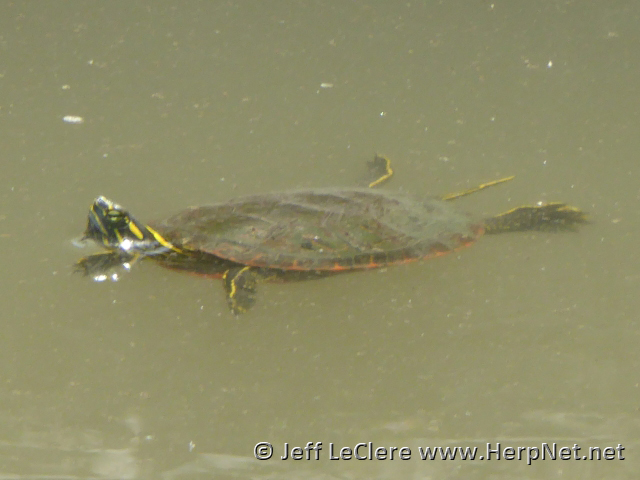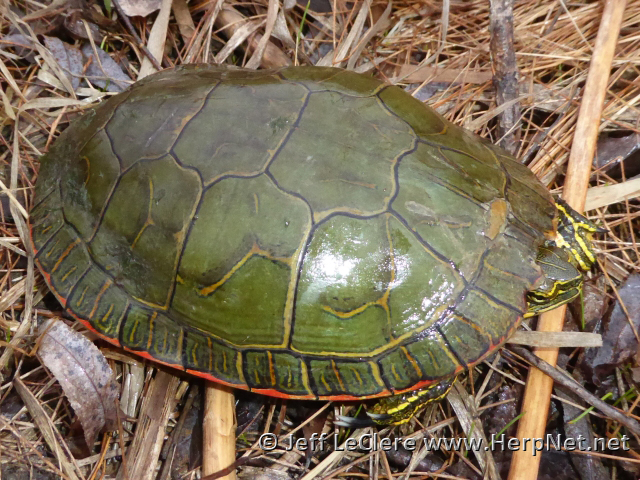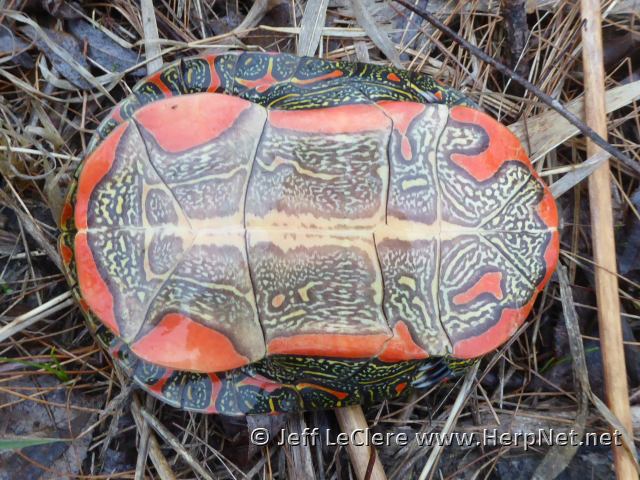Painted Turtle (Chrysemys picta)
by Jeff LeClere
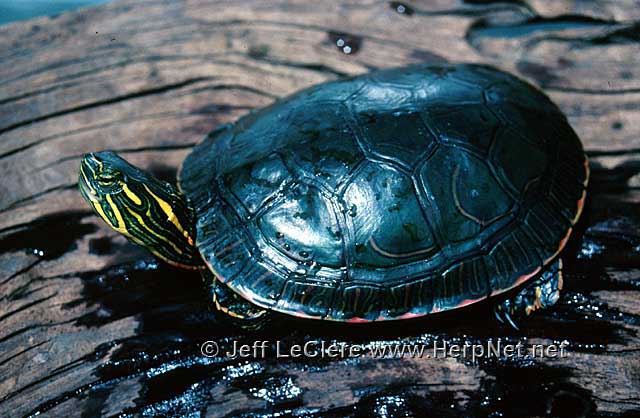
Status
LEGAL to take with a valid fishing license. These turtles may be trapped, taken by hand, hook and line, turtle hook throughout Iowa. The possession limit 100 pounds for live and 50 pounds for dressed turtles.
Description
The painted turtle is probably Iowa’s best known turtle species, with the possible exception of the snapping turtle, Chelydra serpentina. Adults range from 3 1/2-7 inches in carapace length (Conant and Collins, 1991). Males are at the smaller end of this range whereas females grow to the larger size. The carapace is dark with a network of thin, faded yellow stripes. Each marginal is marked with two dark rectangles outlined in orange-red. This pattern wraps under the marginals, but the predominating surrounding color here is red. The plastron is largely red or orange-red on the sides with bold pattern of black and pale yellow.
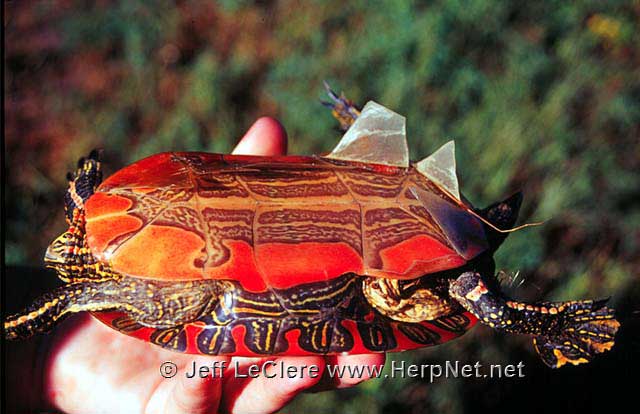
Some individuals may possess a patternless rust-colored plastron. This is caused by chemical absorption from the water (Vogt, 1981). The discoloration can be removed by scraping and/or with the shedding of the plastronal scutes. The ground color of the skin is black (sometimes greenish) with bright yellow stripes on the head, limbs, and tail, sometimes with red centers. The yellow stripes on the head are wide and reach the eyes and the snout. The upper jaw has a notch located just under the nostrils. Males have very long front claws and longer, thicker tails with a cloacal opening that extends past the edge of the carapace. Females have shorter front claws, shorter, thinner tails and their cloacal openings do not extend past the edge of the carapace. The young are similar to adults, but brighter and are 7/8 – 1 1/8 inches at hatching (Conant and Collins 1991).
Subspecies
Of the recognized subspecies, only one, the western painted turtle, Chrysemys picta bellii, occurs in Iowa.
Range
The western painted turtle has the largest range of the subspecies of Chrysemys picta. It occurs statewide.
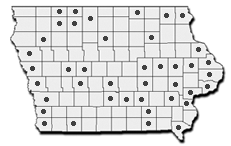
Habitat
The indubitable recognition of this species is owed largely to its versatility in habitat usage. Nearly any permanent body of water with suitable basking sites are inhabited by these colorful turtles. They prefer muddy bottoms and may be seen in rivers, lakes, ponds and marshes. Individuals also may make overland trips to search for new ponds.
Habits
The painted turtle can most readily be seen enjoying its favorite pastime: basking. It is one of Iowa’s first reptiles observed in spring. Individuals can sometimes be seen basking on warm March days. Retiring into an overwintering state in late October, they are one of the last Iowa reptiles to enter their winter sleep. Adults overwinter at the bottom of the lake or pond in the mud. During their active period, they spend time basking interspersed with foraging for food in the water. Often there will be one or more ‘prime’ basking sites where many turtles will sit upon one another, sometimes up to three in a stack.
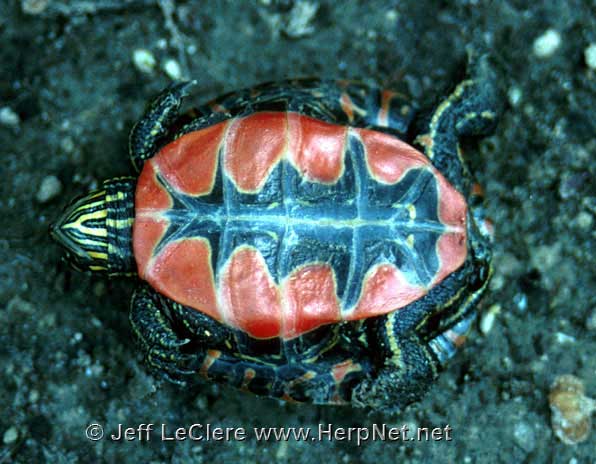
Painted turtles recede to the bottom of the wetland to spend the night. Breeding occurs in spring and sometimes fall. The male swims behind a female as she moves to shallow water. Then he swims past the female and positions himself directly in front of her facing her head-on. Stretching out his forelimbs, he vibrates his long front claws along the females cheeks. Many times she may respond by backing away and swimming onward and thus the male follows and repeats the courtship behavior. When she is ready to breed, she may stroke his forelimbs with her claws. The male mounts the female from behind using his claws to secure his position. Then he moves his tail under hers to breed.
The females are ready to lay their eggs in late May or June. At this time, many females can be observed seeking out their nesting sites which may vary considerably in distance from their aquatic home. A friend and I observed several painted turtles searching for nest sites in eastern Iowa in late May. Often, females must cross roads to reach their destination and unfortunately are hit by motorists. Females mainly choose areas of loose sand or soil that gets plenty of sunshine. She begins by digging a flask shaped nest. She deposits about 7 or 8 eggs, fills the enclosure in, and makes her way back to her home. Sometimes a female will lay two clutches off eggs a year with the second wave of nesting occurring in late June or July.
Sex determination is dependent upon temperature with mostly females resulting at temperature of 84 degrees and up and mostly males below that temp. Depredation upon turtle nests are extremely high, mostly by mammals which are able to dig up the leathery shelled eggs. The young turtles hatch in late August, but the young may overwinter inside the nests and emerge the following spring. They will be ready to reproduce at about four to six years of age (Oldfield and Moriarty, 1994).
Painted turtles are often erroneously referred to as “mud turtles” by many Iowans. True mud turtles are of the genus Kinosternon and do not have the many bright head stripes or the orange-red plastron of the painted turtle.
Food
Western painted turtles are omnivorous, but because they have a fixed tongue, they have difficulty swallowing on land. Their food must be obtained and eaten in the water. They spend time chasing fishes, aquatic insects, tadpoles, frogs, crayfish, snails, and other aquatic animals. They also consume carrion and will browse on different forms of aquatic vegetation. The taste for the herbivorous portion of their diet is acquired with age; the young are mostly carnivorous. Painted turtles which live in waters with muddy substrates have been reported to grow at a faster rate than those found on sand or gravel bottoms (Quinn and Christainsen, 1972).
